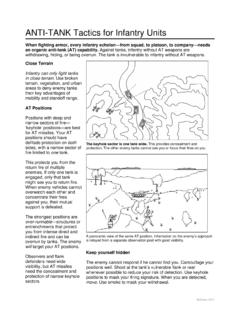Transcription of THE RUSSIAN EXPERIENCE OF URBAN COMBAT - …
1 EFFICIENT READING STRATEGY THE RUSSIAN EXPERIENCE OF URBAN COMBAT - some LESSONS FROM CENTRAL ASIA _____ Flight Sergeant Martin Andrew RAAF* _____ Recent conflicts in the former Soviet Republics of Central Asia have demonstrated the difficulty of dealing with insurgent forces that are well equipped with small arms, especially the rocket-propelled grenade (RPG) in URBAN operations. This article seeks to show how the RUSSIAN military has dealt with the challenge of URBAN COMBAT in Chechnya and Dagestan by the use of combined arms tactics, thermobaric weapons and heavier-calibre small arms.
2 Lessons from the RUSSIAN EXPERIENCE are useful since, as current operations in Iraq now reveal, Western forces need to devise new tactics and techniques to meet the threat of cheap, in URBAN areas that can be used to destroy helicopters and vehicles that are unprotected by infantry. _____ URBAN WARFARE IN CENTRAL ASIA: THE ROLE OF WEAPONS SYSTEMS In recent URBAN conflict in Central Asia, insurgents have made extensive use of the RPG. Long regarded as the poor man s howitzer and the guerilla s artillery , the RPG is particularly effective when used in complex terrain.
3 With a bursting radius of four metres, the RPG kills by blast and shrapnel. In skilled hands, especially in the confines of URBAN terrain, this relatively unsophisticated device excels as a destructive weapons system. In 1992, rebels fighting the RUSSIAN Army in Tajikistan found that, while they lacked the modern PG-7VR tandem warhead that was necessary to destroy RUSSIAN T-72 tanks equipped with reactive armour, they could still destroy RUSSIAN armour. Because the Russians were reluctant to deploy sufficient screening infantry, RPG gunners employed double-teaming against RUSSIAN T-72 tanks.
4 The first gunner would fire at the tank in order to create a breach in its reactive armour. The second and third gunners would then fire multiple kill shots at the exposed area. These rounds would often destroy the _____ * The author wishes to acknowledge the invaluable assistance of Mr Les Graw of the Foreign Military Studies Office, Center for Army Lessons Learnt, US Army, in developing the ideas in this article. _____ The clearing and screening action of RUSSIAN all-arms teams led to greater protection for the armoured forces.
5 _____ _____ In Grozny, RUSSIAN tanks and armoured vehicles, unsupported by dismounted infantry, became easy prey for Chechen _____ tank crew s line of vision, ensuring that the crew would be unable to counter the enemy even if the vehicle survived multiple rocket hits. Inflicting such blindness on a tank then allowed the RPG gunners time to reposition and resume their attack until the vehicle was disabled. Another technique employed by Tajik rebels was to fire a fragmentation round, or a white phosphorus grenade, at the T-72 s front deck in order to disable the driver s vision before massed groups of fighters employing RPGs fired on the tank, aiming to disable the rear section of the turret.
6 The assault on Grozny in Chechnya by the RUSSIAN 131st Maycop Brigade on New Year s Eve 1995 is an instructive example of what can occur if a modern army engages in URBAN warfare against well-armed insurgents without using proper combined-arms tactics and weapons systems. In Grozny, RUSSIAN tanks and armoured vehicles, unsupported by dismounted infantry, became easy prey for Chechen forces employing three-or four- man fire teams composed of an RPG gunner, a machine-gunner and a sniper.
7 The Chechen hunter-killer teams, like wolf packs searching out an isolated member of a family of deers, frequently attacked a single armoured vehicle simultaneously from several different directions, peppering it with rockets, grenades and Molotov cocktails. Areas that might be targeted included the crew hatches, the engine transmission compartment, decking and the area behind the turret. Because of the absence of significant numbers of dismounted RUSSIAN infantry, the Chechen fighters turned the streets of Grozny into death traps for RUSSIAN armoured vehicles.
8 By early January 1995, the Maykop Brigade had suffered extraordinary casualties of 800 dead and wounded. The brigade had also lost twenty out of twenty-six tanks, 102 out of 120 infantry fighting vehicles and all six of their ZSU-23 self-propelled antitank guns. RUSSIAN COMBINED ARMS AND WEAPONS IN CHECHNYA In late 1999 and early 2000, when the Russians again attacked Grozny, they adopted different tactics and weapons. The RUSSIAN Army deployed combined arms teams composed of tanks, infantry, engineers and artillery.
9 In particular, the Russians employed specialised troika fire teams comprising a sniper, a machine-gunner and a soldier equipped with a grenade launcher. Two other soldiers, acting as ammunition carriers or assistant gunners, supplemented these teams. The use of RUSSIAN fire teams forced Chechen fire teams to abandon fixed positions on upper floors of buildings, on balconies and in attics. The clearing and screening action of RUSSIAN all-arms teams led to greater protection for the armoured forces.
10 Using manoeuvre by fire against buildings, apartment blocks and strong points, RUSSIAN troops were able to counter the supremacy of Chechen URBAN tactics. The Russians also discovered that, in conditions of short-range URBAN operations, _____ Ultimately, it was the use of combined arms teams in Chechnya, along with superior firepower, that restored the RUSSIAN military s fortunes. _____ anti-armour rounds lacked impact. As a result they adopted the OG-7V fragmentation round and the TBG-7V thermobaric for use in URBAN COMBAT .

